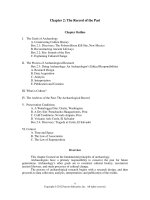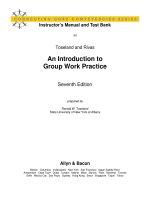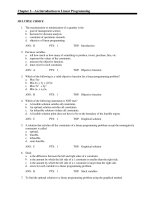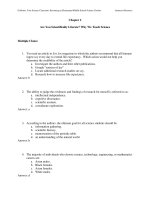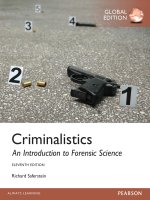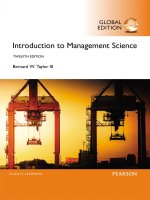An introduction to psychological science canadian 1st edition by krause corts smith dolderman test bank
Bạn đang xem bản rút gọn của tài liệu. Xem và tải ngay bản đầy đủ của tài liệu tại đây (734.08 KB, 99 trang )
Krause, Corts, Dolderman, Smith, Psychological Science, Canadian
Edition, Chapter 2: Reading and Evaluating Scientific
Research
Link full download test bank: />Link full download solution manual: />
1) Before beginning an experiment, researchers use operational definitions to define exactly how
variables like "intelligence" or "happiness" will be measured.
Correct: Operational definitions are statements that describe the procedures (or operations)
and/or specific measures that are used to record observations. By carefully defining
psychological terms such as "intelligence" or "happiness," everyone can understand exactly
how these variables are being objectively measured.
Diff: 2
Type: FIB
Page Reference: 33
Skill: Factual
Objective: Know the key terminology related to the principles of scientific research.
2) Demand characteristics are a major problem in psychology research, and can cause
participants to change their behavior based on how they think they are supposed to behave.
Correct: Demand characteristics are inadvertent cues given off by the experimenter or the
experimental context that provide information about how participants are expected to behave.
Demand characteristics can range from very subtle to obvious influences on the behavior of
research participants
Diff: 2
Type: FIB
Page Reference: 36-38
Skill: Conceptual
Objective: Understand how biases might influence the outcome of a study.
3) Before research findings can be published they go through peer review, which is a process in
which papers submitted to publication in scholarly journals are read and critiqued by experts
in the specific field of study.
Correct: In the peer review process, the editors and reviewers serve as gatekeepers for the
discipline, ensuring that the best research is made public.
Diff: 2
Type: FIB
Page Reference: 39
Skill: Factual
Objective: Know the key terminology related to the principles of scientific research.
4) Tabitha is convinced that vaccines cause autism because her friend's child was diagnosed with
autism only a week after being vaccinated. Because Tabitha's "evidence" is essentially a story
Copyright © 2015 Pearson Canada Inc.
Page 1 of 4
Krause, Corts, Dolderman, Smith, Psychological Science, Canadian
Edition, Chapter 2: Reading and Evaluating Scientific
Research
about one person, it should be considered anecdotal evidence and cannot be considered
reliable.
Correct: Anecdotal evidence is an individual's story about an observation or event that is used
to make a claim as evidence. Although sometimes correct, it is too unreliable to form a basis
for scientific conclusions, even if the basic facts of the story are correct.
Diff: 2
Type: FIB
Page Reference: 41
Skill: Applied
Objective: Analyze whether anecdotes, authority figures, and common sense are reliably
truthful sources of information.
5) Case studies, naturalistic observation, and surveys and questionnaires are all types of
descriptive research, because they can only be used to collect observations.
Correct: The goal of descriptive research is to simply describe the thing being studied. In
psychology, this is usually accomplished by using case studies, naturalistic observation, or
surveys and questionnaires.
Diff: 2
Type: FIB
Page Reference: 45
Skill: Conceptual
Objective: Know the key terminology related to research designs.
6) Experimental designs are the only research method that can provide strong evidence for
cause-and-effect relationships.
Correct: It is the manipulation of variables along with random assignment that allows an
experiment to make cause-and-effect conclusions about the independent and dependent
variables.
Diff: 2
Type: FIB
Page Reference: Module 2.2
Skill: Factual
Objective: Understand how experiments help demonstrate cause-and-effect relationships.
7) To study the effect of subliminal advertising on consumer behavior, participants were
randomly assigned to watch a movie either with or without subliminal advertising. The group
of participants that saw the movie without the ads is called the control group.
Copyright © 2015 Pearson Canada Inc.
Page 2 of 4
Krause, Corts, Dolderman, Smith, Psychological Science, Canadian
Edition, Chapter 2: Reading and Evaluating Scientific
Research
Correct: A control group is the group that does not receive the treatment and therefore serves
as a comparison for the experimental group(s).
Diff: 2
Type: FIB
Page Reference: 52
Skill: Applied
Objective: Know the key terminology related to research designs.
8) Research participants in psychology studies must give informed consent, meaning that they
are told about the experiment—including any potential risks—and then freely agree to
participate.
Correct: Current research practice uses the concept of informed consent: A potential
volunteer must be informed (know the purpose, tasks, and risks involved in the study) and give
consent (agree to participate based on the information provided) without pressure.
Diff: 2
Type: FIB
Page Reference: 56
Skill: Conceptual
Objective: Know the key terminology of research ethics.
9) The normal distribution is a commonly occurring distribution that is characterized by its
symmetrical shape with values clustered around a mean value.
Correct: A normal distribution (sometimes called the bell curve) is a symmetrical distribution
with values clustered around a central, mean value. Many variables wind up in a normal
distribution, such as the scores on most standardized tests or the average high temperature in
Moose Jaw, Saskatchewan, throughout the month of January.
Diff: 1
Type: FIB
Page Reference: 65
Skill: Conceptual
Objective: Know the key terminology of statistics.
10) If the difference between groups in an experiment is unlikely to have occurred by random
chance alone, the difference is said to be statistically significant.
Correct: A difference is said to be statistically significant when the analyses indicate that
there is a lot probability that the outcome occurred by chance.
Diff: 2
Copyright © 2015 Pearson Canada Inc.
Page 3 of 4
Krause, Corts, Dolderman, Smith, Psychological Science, Canadian
Edition, Chapter 2: Reading and Evaluating Scientific
Research
Type: FIB
Page Reference: 70
Skill: Conceptual
Objective: Know the key terminology of statistics.
Copyright © 2015 Pearson Canada Inc.
Page 4 of 4
Krause, Corts, Dolderman, Smith, Psychological Science, Canadian
Edition, Chapter 2: Reading and Evaluating Scientific
Research
1) A large group of people whom you want to know about is called a
.
a. control group
b. treatment group
c. population
d. sample
Answer: c
Page Reference: 35
2) A scientist, conducting a research study on sleep and learning, questions her own
objectivity and decides to let a third person, not associated with conducting the
experiment, score the tests. The scientist is probably trying to eliminate
.
a. experimenter bias
b. sample bias
c. control bias
d. treatment bias
Answer: a
Page Reference: 37
3) A psychologist, studying pilot trainees, picks a select group of trainees who she hopes
representative of all other trainees. The group of trainees being studied by this
psychologist is collectively known to researchers as a
.
a. sample
b. population
c. target group
d. control group
Answer: a
Page Reference: 35
4) Expectations by the experimenter that might influence the results of an experiment or
their interpretation are called
.
a. experimental blinds
b. experimenter bias
c. sample bias
d. treatment bias
Copyright © 2015 Pearson Canada Inc.
Page 1 of 20
Krause, Corts, Dolderman, Smith, Psychological Science, Canadian
Edition, Chapter 2: Reading and Evaluating Scientific
Research
Answer: b
Page Reference: 37
5) A subset of cases selected from a larger population is a
.
a. control group
b. target group
c. treatment group
d. sample
Answer: d
Page Reference: 35
6) A sample that does not truly represent the population in question is known as a
sample.
a. random
b. chance
c. biased
d. representative
Answer: c
Page Reference: 35
7) Experimenter bias can best be controlled using
.
a. a placebo
b. double-blind control
c. randomization
d. subjects who do not know the purpose of the study
Answer: b
Page Reference: 37
8) One of the main reasons for using a laboratory for psychological research is to
a. prevent subjects from escaping.
b. study behaviour in a natural setting.
c. do large-scale studies.
Copyright © 2015 Pearson Canada Inc.
Page 2 of 20
Krause, Corts, Dolderman, Smith, Psychological Science, Canadian
Edition, Chapter 2: Reading and Evaluating Scientific
Research
d. allow the researchers to control certain factors.
Answer: d
Page Reference: 34
9) A ‖fake treatment‖ is one way to define a
.
a. decoy
b. demand characteristic
c. control group
d. placebo
Answer: d
Page Reference: 38
10) To determine if sugar-rich diets affect hyperactivity in kids, a researcher prepared
two daily menus that children would receive for a 30-day period. A high-sugar diet was
given to the boys, while the girls had a menu that seemed identical but was not a highsugar diet. At the end of 30 days, the boys and girls were evaluated to determine their
levels of hyperactivity. In the study, the high-sugar diet is the
.
a. placebo
b. independent variable
c. dependent variable
d. control group
Answer: b
Page Reference: 38
11) Dr. Welsh is doing experiments using drugs. He is concerned that his subjects will
respond to demand characteristics. He may want to control for this by using which of the
following?
a. stratification
b. two independent variables
c. a placebo
d. randomization
Answer: c
Page Reference: 38
Copyright © 2015 Pearson Canada Inc.
Page 3 of 20
Krause, Corts, Dolderman, Smith, Psychological Science, Canadian
Edition, Chapter 2: Reading and Evaluating Scientific
Research
12) Mr. Marshall hired June to collect data from a group of subjects. Neither June nor the
subjects were aware of the independent variable that Mr. Marshall had manipulated. This
is an example of
.
a. randomization
b. a placebo
c. double-blind control
d. experimenter bias
Answer: c
Page Reference: 39
13) Experimenter bias can best be controlled using
.
a. a placebo
b. double-blind control
c. randomization
d. subjects who do not know the purpose of the study
Answer: b
Page Reference: 39
14) Observing behaviour as it happens in real-life natural settings without imposing
laboratory controls is known as the
.
a. naturalistic observation method
b. experimental method
c. correlational method
d. psychometric approach
Answer: a
Page Reference: 47
15) Research in which a carefully selected group of people is asked a set of
predetermined questions in interviews or through questionnaires is known as
.
a. correlational research
b. case study research
c. survey research
d. experimental research
Copyright © 2015 Pearson Canada Inc.
Page 4 of 20
Krause, Corts, Dolderman, Smith, Psychological Science, Canadian
Edition, Chapter 2: Reading and Evaluating Scientific
Research
Answer: c
Page Reference: 48
16) A research method in which the real-life behaviour of a pre-selected person or a
group is studied in depth for some time through the use of observation, interviews, and
writings (such as letters) is the
method of research.
a. survey
b. psychometric
c. case study
d. naturalistic observation
Answer: c
Page Reference: 45
17) As part of an assignment, Bill's class was asked to complete an anonymous
questionnaire on prejudice. Which research method was Bill's professor using?
a. field experiment
b. survey
c. naturalistic observation
d. laboratory experiment
Answer: b
Page Reference: 48
18) Naturalistic observation is
.
a. re-creating natural conditions in the laboratory as closely as possible to make an
experiment more valid
b. studying behaviour in its natural context
c. basically the same process as objective introspection
d. observing behaviour in the lab without taking formal notes or using technological
equipment to measure the experiment findings
Answer: b
Page Reference: 47
Copyright © 2015 Pearson Canada Inc.
Page 5 of 20
Krause, Corts, Dolderman, Smith, Psychological Science, Canadian
Edition, Chapter 2: Reading and Evaluating Scientific
Research
19) Collecting objective data without interference in the subject's normal environment is
associated with
_.
a. survey research
b. applied research
c. laboratory research
d. naturalistic observation
Answer: d
Page Reference: 47
20) Positive correlation shows
a. the extent to which two independent variables change together.
b. that as one independent variable increases, another decreases.
c. that as one variable changes, another changes in the same direction.
d. that as one variable changes, another changes in the opposite direction.
Answer: c
Page Reference: 50
21) A researcher wished to study the relationship between high school grades and postsecondary grades. Of the following research methods, which would be the most
appropriate?
a. case study
b. correlation
c. experiment
d. survey
Answer: b
Page Reference: 50
22) A correlation of .00 means
a. you made a mistake in calculation.
b. you did not find out anything about the relationship between the two variables.
c. the two variables are unrelated.
d. everyone who scored low on one variable scored high on the other variable, and vice
versa.
Copyright © 2015 Pearson Canada Inc.
Page 6 of 20
Krause, Corts, Dolderman, Smith, Psychological Science, Canadian
Edition, Chapter 2: Reading and Evaluating Scientific
Research
Answer: c
Page Reference: 50
23) A correlation tells us
a. whether a cause-effect relationship exists.
b. whether two variables are related
c. whether or not a test is efficient.
d. if people are responding to demand characteristics.
Answer: b
Page Reference: 49
24) A psychologist uses the correlational method to
.
a. explain the effects of one variable on another
b. compare two groups of subjects
c. determine what causes a variable to change
d. identify relationships between variables
Answer: d
Page Reference: 49–50
25) As children grow older, their discretionary income usually increases. The best
conclusion to draw about the variables age and income are that they are
a. causally related.
b. uncorrelated.
c. negatively correlated.
d. positively correlated.
Answer: d
Page Reference: 50
26) In an experiment to test the effects of anxiety on performance, the dependent variable
is the
.
a. amount of anxiety
b. age of the person
c. person's performance
Copyright © 2015 Pearson Canada Inc.
Page 7 of 20
Krause, Corts, Dolderman, Smith, Psychological Science, Canadian
Edition, Chapter 2: Reading and Evaluating Scientific
Research
d. cause of the anxiety
Answer: c
Page Reference: 52
27) In an experiment, a researcher manipulates one variable to see how it affects a second
variable. The second variable, which is observed for any possible effects, is called the
.
a. dependent variable
b. control variable
c. independent variable
d. hypothetical variable
Answer: a
Page Reference: 52
28) In a controlled experiment, the group subjected to a change in the independent
variable is called the
group.
a. independent
b. experimental
c. dependent
d. control
Answer: b
Page Reference: 52
29) If explanation of the causes of thoughts, feelings, and behaviour is a psychologist's
goal, then the
method of research should be used.
a. correlational
b. experimental
c. survey
d. naturalistic observation
Answer: b
Page Reference: 51–52
Copyright © 2015 Pearson Canada Inc.
Page 8 of 20
Krause, Corts, Dolderman, Smith, Psychological Science, Canadian
Edition, Chapter 2: Reading and Evaluating Scientific
Research
30) In a controlled experiment, the group not subjected to a change in the independent
variable, and used for comparison with the group receiving the experimental change, is
the
group.
a. independent
b. experimental
c. dependent
d. control
Answer: d
Page Reference: 52
31) In an experiment, a researcher manipulates one variable to see how it affects a second
variable. The manipulated variable is called the
a. dependent variable.
b. experimental variable.
c. independent variable.
d. placebo.
Answer: c
Page Reference: 52
32) A group of students was asked to write an essay in support of the legalization of
marijuana. They were paid $0.50. Another group of students received $2.00 for the same
task. It was subsequently found that those students who received only $0.50 developed a
more positive attitude towards the legalization of marijuana. The experiment in this study
was using (the)
a. correlational method.
b. experimental method.
c. naturalistic observation.
d. survey research.
Answer: b
Page Reference: 51–52
33) Using both independent and dependent variables is associated with which of the
following types of research used in psychology?
a. experimentation
b. naturalistic observation
Copyright © 2015 Pearson Canada Inc.
Page 9 of 20
Krause, Corts, Dolderman, Smith, Psychological Science, Canadian
Edition, Chapter 2: Reading and Evaluating Scientific
Research
c. correlation
d. correlation and experimentation
Answer: a
Page Reference: 52
34) A researcher, based on her review of relevant scientific studies, believes that there is
a relationship between the frequency of a baby's crying and whether it was nursed at set
intervals or on a demand schedule. If this belief were tested by experimentally
manipulating feeding schedules, the feeding schedule would be called the
a. independent variable.
b. dependent variable.
c. extraneous variable.
d. control factors.
Answer: a
Page Reference: 52
35) A researcher, based on her review of relevant scientific studies, believes that there is
a relationship between the frequency of a baby's crying and whether it was nursed at set
intervals or on a demand schedule. If this belief were tested by experimentally
manipulating feeding schedules, frequency of crying would be called the
a. latent factor.
b. dependent variable.
c. independent variable.
d. control factor.
Answer: b
Page Reference: 52
36) The process of establishing causal relationships is associated most with
a. naturalistic observation.
b. experiments.
c. correlation.
d. surveys.
Answer: b
Page Reference: 51–52
Copyright © 2015 Pearson Canada Inc.
Page 10 of 20
Krause, Corts, Dolderman, Smith, Psychological Science, Canadian
Edition, Chapter 2: Reading and Evaluating Scientific
Research
37) A researcher tests the hypothesis that students who study in the room where they take
their tests will perform better on the tests than students who study in other rooms. She
requires one group to study in the classroom where the exam is given and another group
to study in the library. All students take the test in the classroom, and their test
performance is compared. In this example, where students study is the
a. independent variable.
b. dependent variable.
c. manipulation.
d. hypothesis.
Answer: a
Page Reference: 52
38) In psychological studies, random assignment is used to ensure that
a. there will be an independent and a dependent variable.
b. each person has an equal chance of being assigned to each group.
c. the control group does not know the purpose of the study.
d. the experimenter won't know who is in each group.
Answer: b
Page Reference: 51
39) The method of psychological research that utilizes a control group, a dependent
variable, and an independent variable is
a. the experiment.
b. the survey.
c. the case study.
d. naturalistic observation.
Answer: a
Page Reference: 51–52
40) Professor McSpell designed an experiment to test her hypothesis that exercise will
increase spelling ability. She divided children into three groups and had one group do 10
minutes of exercises, one group do 30 minutes of exercises, and the third group do no
exercise. She then tested all three groups of children to see how many words they could
spell correctly on a spelling test. In this experiment, the scores on the spelling test serve
as the
Copyright © 2015 Pearson Canada Inc.
Page 11 of 20
Krause, Corts, Dolderman, Smith, Psychological Science, Canadian
Edition, Chapter 2: Reading and Evaluating Scientific
Research
a. dependent variable.
b. independent variable.
c. control group.
d. reliability measure.
Answer: a
Page Reference: 52
41) Which of the following is a strength of experiments?
a. They cannot be repeated by anyone other than the experimenter.
b. They allow for the establishment of cause-effect relationships.
c. They are not subject to demand characteristics since the subjects do not know they are
being observed.
d. They allow us to draw definitive conclusions about behaviour in the natural
environment based on subjects' behaviour in the laboratory.
Answer: b
Page Reference: 53
42) In an experiment, the ‖measurable aspect of the behaviour of the subject‖ is called the
variable.
a. dependent
b. focal
c. independent
d. control
Answer: a
Page Reference: 52
43) The purpose of an experiment is to discover whether there is a relationship between
the
and the
.
a. independent variable; control variable
b. dependent variable; control variable
c. control group; experimental group
d. independent variable; dependent variable
Answer: d
Page Reference: 52
Copyright © 2015 Pearson Canada Inc.
Page 12 of 20
Krause, Corts, Dolderman, Smith, Psychological Science, Canadian
Edition, Chapter 2: Reading and Evaluating Scientific
Research
44) Cause-and-effect conclusions can be drawn from the results of an experiment because
a. it is almost always performed in a laboratory setting.
b. statistical analysis can be applied to data from an experiment.
c. the independent variable is manipulated while other possible causes of change in the
dependent variable are held constant.
d. several groups of subjects, not just one sample, are typically investigated in a
laboratory experiment.
Answer: c
Page Reference: 52
45) In an experiment on the effects of level of motivation on the performance of typists,
the researcher randomly assigned one-third of her subjects to each of three levels of
motivation (and then induced different levels of motivation in the three groups). She
measured the average words typed per minute by each group, and found that performance
was highest under medium motivation, average under low motivation, and worst under
high motivation. What was the independent variable in this experiment?
a. motivation
b. typing speed
c. variation in typing speed
d. manipulation of typing speed
Answer: a
Page Reference: 52
46) A psychologist wanted to see if people are more prone to seek the company of others
when anxious than when calm. He randomly assigned half of his subjects to an anxiety
group and then told them that, as part of the study, they would receive electric shocks. He
did not frighten the other group of subjects. Finally, he recorded how many subjects in
each group chose to be ‖tested‖ in a group setting and how many chose to be ‖tested‖
alone. What was the independent variable in this study?
a. tendency to desire the company of others
b. level of shock
c. level of anxiety
d. the anxious group
Answer: c
Page Reference: 52
Copyright © 2015 Pearson Canada Inc.
Page 13 of 20
Krause, Corts, Dolderman, Smith, Psychological Science, Canadian
Edition, Chapter 2: Reading and Evaluating Scientific
Research
47) In an experiment, four groups of college students used different memorizing
strategies to learn the material in one chapter of a textbook. Then each group was given
the same multiple-choice test on the material. What was the dependent variable in this
study?
a. the students' performance on the test
b. the four different groups
c. the four different memorizing strategies
d. manipulation of memorizing strategies
Answer: a
Page Reference: 52
48) A psychologist wanted to see if people are more prone to seek the company of others
when anxious than when calm. He randomly assigned half of his subjects to an anxiety
group and then told them that, as part of the study, they would receive electric shocks. He
did not frighten the other group of subjects. Finally, he recorded how many subjects in
each group chose to be ‖tested‖ in a group setting and how many chose to be ‖tested‖
alone. What was the dependent variable in this study?
a. the two groups
b. the level of anxiety
c. preference for being alone or in a group
d. manipulation of anxiety
Answer: c
Page Reference: 52
49) A psychologist wanted to see if people are more prone to seek the company of others
when anxious than when calm. He randomly assigned half of his subjects to an anxiety
group and then told them that, as part of the study, they would receive electric shocks. He
did not frighten the other group of subjects. Finally, he recorded how many subjects in
each group chose to be ‖tested‖ in a group setting and how many chose to be ‖tested‖
alone. In this study, the group that was NOT frightened would be called the
group.
a. experimental
b. control
c. placebo
d. test
Copyright © 2015 Pearson Canada Inc.
Page 14 of 20
Krause, Corts, Dolderman, Smith, Psychological Science, Canadian
Edition, Chapter 2: Reading and Evaluating Scientific
Research
Answer: b
Page Reference: 52
50) The purpose of a control group in an experiment is to
a. serve as a check on the interpretation of results.
b. increase the ability to generalize the findings.
c. manipulate the dependent variable.
d. represent the general, nonlaboratory population.
Answer: a
Page Reference: 52
51) In an experiment, the group of subjects to which the experimental group is compared
is called the
a. comparison group.
b. standard group.
c. confederate group.
d. control group.
Answer: d
Page Reference: 52
52) In an experiment concerning the effect of auditory feedback on accuracy in writing
computer programs, one group hears a computer-simulated voice say each character or
symbol that they type in as they are writing their programs. The second group does not
receive the auditory feedback as they type their program lines. This second group is the
group.
a. experimental
b. control
c. placebo
d. confederate
Answer: b
Page Reference: 52
53) Why is it essential that the experimental and control groups be treated identically in
every respect but one?
a. so that the dependent variable can be accurately measured
Copyright © 2015 Pearson Canada Inc.
Page 15 of 20
Krause, Corts, Dolderman, Smith, Psychological Science, Canadian
Edition, Chapter 2: Reading and Evaluating Scientific
Research
b. so that the results will apply outside the laboratory setting.
c. so that if the behaviour of the two groups differs, the difference can be credited to the
one thing that distinguished the groups from one another
d. so that if the behaviour of the two groups differs, that difference can be used to
establish a functional relationship between the independent and dependent variables
Answer: d
Page Reference: 52
54) An experiment was run in which group A was given 3 minutes to study a word list,
while group B was given 10 minutes to study the same list. Later, both groups were asked
to recall words from the list. In this study, the number of words recalled is the
.
a. independent variable
b. dependent variable
c. placebo
d. control group
Answer: b
Page Reference: 52
55) To obtain objective information, researchers sometimes must deceive their subjects.
Ethically, research involving deception must always
.
a. pay participants
b. maintain subject anonymity
c. use double-blind control
d. explain the deception to the subjects after the data are collected and obtain their
informed consent to use the information obtained
Answer: d
Page Reference: 58
56) Sasha read about a study in the newspaper that reported a relationship between
schizophrenia and crime. What type of research design was most likely used in this
study?
a. naturalistic observation
b. case study design
c. correlational design
Copyright © 2015 Pearson Canada Inc.
Page 16 of 20
Krause, Corts, Dolderman, Smith, Psychological Science, Canadian
Edition, Chapter 2: Reading and Evaluating Scientific
Research
Correct: Correlation is used to study things that cannot be manipulated in a lab, such as
criminal acts.
d. experimental design
Answer: c
Diff: 1
Type: MC
Page Reference: 49, Module 2.2
Skill: Applied
Objective: Know the key terminology related to research designs.
57) Which term best describes the correlation between depression and fatigue?
a. illusory
b. zero
c. positive
Correct: Two variables that increase or decrease together are positively correlated.
d. negative
Answer: c
Diff: 2
Type: MC
Page Reference: 49, Module 2.2
Skill: Factual
Objective: Understand what it means when variables are positively or negatively
correlated.
58) Which term best describes the correlation between the full moon and violent crime?
a. positive
b. negative
c. zero
d. illusory
Correct: Many believe there is a correlation between violent crime and the moon but no
correlation actually exists.
Answer: d
Diff: 2
Copyright © 2015 Pearson Canada Inc.
Page 17 of 20
Krause, Corts, Dolderman, Smith, Psychological Science, Canadian
Edition, Chapter 2: Reading and Evaluating Scientific
Research
Type: MC
Page Reference: 49, Module 2.2
Skill: Applied
Objective: Understand what it means when variables are positively or negatively
correlated.
59) What is the primary weakness of a scale that adds two kilograms to everything it
weighs?
a. poor test-retest reliability
b. low interrater reliability
c. the placebo effect
d. lack of validity
Correct: A scale that does not measure what it is intended to measure is not valid.
Answer: d
Diff: 3
Type: MC
Page Reference: 32,Module 2.1
Skill: Applied
Objective: Understand the five characteristics of quality scientific research.
60) Under which circumstance is the use of deception justified by ethics review boards?
a. when the study could not have been conducted without deception
Correct: Some topics of value cannot be studied without some deception.
b. when the research involves a medical or therapeutic intervention
c. when participants might not agree to participate unless deception is used
d. when the placebo effect is likely to occur
Answer: a
Diff: 2
Type: MC
Page Reference: 57–58,Module 2.3
Skill: Factual
Objective: Analyze the role of using deception in psychological research.
Copyright © 2015 Pearson Canada Inc.
Page 18 of 20
Krause, Corts, Dolderman, Smith, Psychological Science, Canadian
Edition, Chapter 2: Reading and Evaluating Scientific
Research
61) When plotting data, Dr. Ryeburn notes that the distribution has an elongated tail to
the right. Which descriptive statistic would offer the best measure of central tendency in
this case?
a. mean
b. median
Correct: When a distribution is skewed, the median gives a better measure of central
tendency.
c. standard deviation
d. range
Answer: b
Diff: 1
Type: MC
Page Reference: 66, Module 2.4
Skill: Conceptual
Objective: Analyze the choice of central tendency statistics based on the shape of the
distribution.
62) Dr. Jamal has decided to increase the sample size of a study from 20 participants to
100 participants. What is the most likely impact of this decision?
a. The results are more likely to be practically significant.
b. The results are more likely to be statistically significant.
Correct: Larger sample sizes increase statistical power.
c. The results are more likely to have face validity.
d. The results are more likely to be reliable.
Answer: b
Diff: 1
Type: MC
Page Reference: 70, Module 2.4
Skill: Applied
Objective: Understand how and why psychologists use significance tests.
63) Mario is researching the topic of obsessive-compulsive disorder as part of a course
requirement. Which source of online information would most likely be peer reviewed?
a. Wikipedia
b. AboutOCD.com
Copyright © 2015 Pearson Canada Inc.
Page 19 of 20
Krause, Corts, Dolderman, Smith, Psychological Science, Canadian
Edition, Chapter 2: Reading and Evaluating Scientific
Research
c. Scientific American website
Correct: This website reports scientific studies from peer-reviewed journals.
d. YouTube
Answer: c
Diff: 1
Type: MC
Page Reference: 39, Module 2.1
Skill: Applied
Objective: Understand the importance of reporting and storing data.
64) In a test of the effects of sleep deprivation on problem-solving skills, research
participants are allowed to sleep either four or eight hours on each of three consecutive
nights. This research is an example of
a. naturalistic observation.
b. survey research.
c. a case study.
d. an experiment.
Correct: When there is an independent variable and a dependent variable, you have an
experiment.
Answer: d
Diff: 1
Type: MC
Page Reference: 51, Module 2.2
Skill: Conceptual
Objective: Apply the terms and concepts of experimental methods to research examples.
Copyright © 2015 Pearson Canada Inc.
Page 20 of 20
Krause, Corts, Dolderman, Smith, Psychological Science, Canadian
Edition, Chapter 2: Reading and Evaluating Scientific
Research
1) What are the five characteristics of good research described in the textbook? Briefly
explain each.
Answer:
A good answer will include the following key points.
- Research should be based on measurements that are
* objective: consistent across instruments and observers
* valid: actually measure what they claim to measure
* reliable: provide consistent answers when remeasured
- Good research can be generalized to situations, individuals, and events beyond the
original study.
- It should use techniques to reduce bias from both the participants and the experimenters.
- Research should be made public, usually through the peer-review process and
publication in an academic journal.
- Finally, it must be possible for other researchers to replicate the results of good
research.
Page Reference: 32–35
2) Anecdotal evidence, appeals to authority, and appeals to common sense are all
considered poor forms of evidence. Provide an example of each and explain why claims
based on them cannot be trusted.
Answer:
Anecdotal evidence is the experience of one person generalized into a theory, such as a
person listens to hypnosis CDs and loses 58 pounds in three months. This is anecdotal
evidence and not real evidence because no hypothesis was tested in developing the
theory. The result could have been for any number of things other than the CD causing
the weight loss. Appeal to authority is evidence from an ―expert‖ that is assumed to be
valid and reliable simply because an expert said it was true. An expert may claim to have
found a great weight-loss program but experts can be wrong and experts can have hidden
agendas. It is important to see what the expert may have to gain by claiming an untested
theory is true. Appeal to common sense is evidence that sounds like it must be true but
hasn’t necessarily been tested. A great example is that people long thought that the earth
was stationary and the centre of the universe because this theory made sense based on
their other (limited) knowledge of the cosmos. The best theory is always based on the
results of hypotheses tested using the scientific method.
Page Reference: 41–42
3) Describe and compare correlational research and experimental research. What key
advantage does experimental research have over correlational research?
Copyright © 2015 Pearson Canada Inc.
Page 1 of 2
